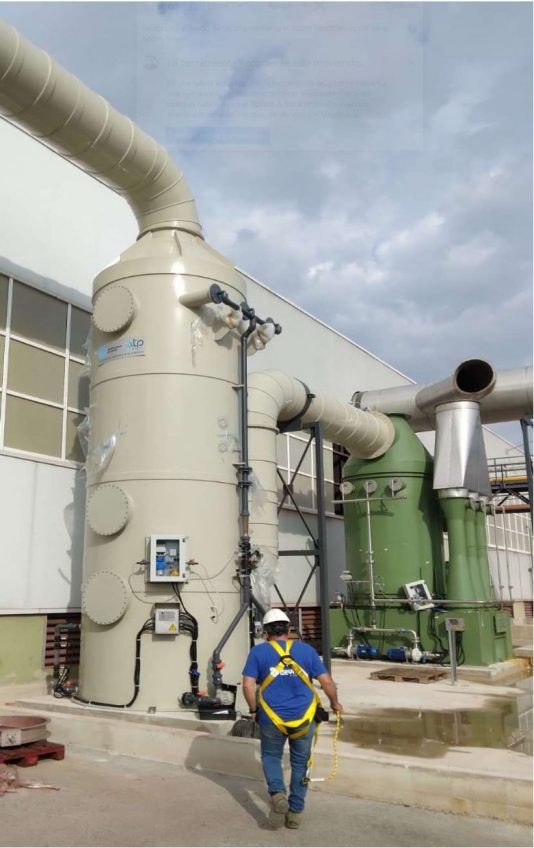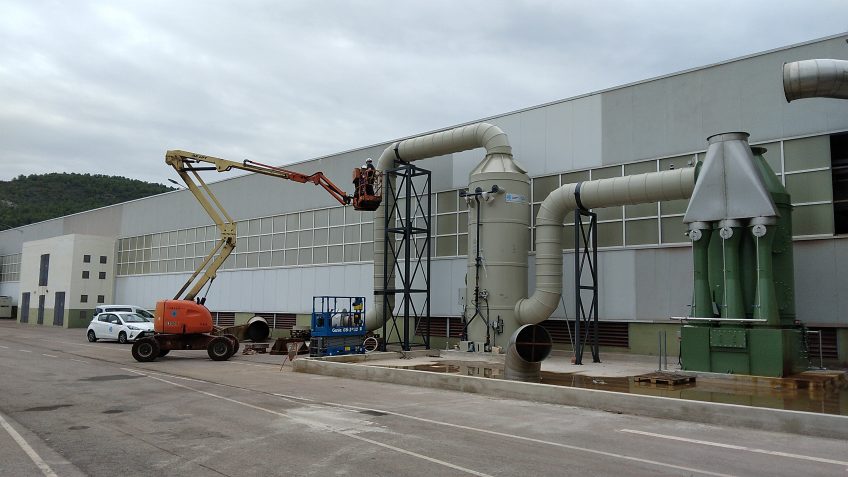Sections
The ceramic industry plays a crucial role in various sectors, providing essential materials for construction, household goods, and artistic creations. However, alongside its economic contributions, the industry also generates air emissions that can pose environmental and health risks if not properly managed.
In this article, we will explore the pollutants generated in ceramic industry, the harmful effects of air emissions, pollution control strategies and technologies, and the importance of managing air emissions for ceramic manufacturers.
- Emission of pollutants in the ceramic industry
- Pollution control technologies
- The importance of managing air pollution in the ceramic industry
Emission of pollutants in the ceramic industry
Air emissions from ceramic manufacturing processes contribute to air pollution and pose health risks to workers and nearby communities. These emissions can cause respiratory problems, cardiovascular diseases, and environmental damage, highlighting the urgency of effective pollution control measures.
- Particulate Matter (PM): Particulate matter is a mixture of tiny solid particles and liquid droplets that can be released into the air during ceramic manufacturing processes such as grinding, cutting, and polishing. These particles can cause respiratory problems when inhaled, such as asthma, bronchitis, and lung cancer.
- Volatile Organic Compounds (VOCs): VOCs are chemicals that can be released into the air during ceramic production, particularly during glazing and firing processes. They can contribute to the formation of ground-level ozone and smog, which can harm human health, cause respiratory problems, and damage crops and vegetation.
- Nitrogen Oxides (NOx): NOx is a group of gases that can be emitted during ceramic manufacturing processes such as firing. They can contribute to the formation of acid rain, smog, and ground-level ozone, which can cause respiratory problems and damage vegetation.
- Sulfur dioxide (SO2): SO2 is a gas that can be released during the firing of ceramics. It can contribute to the formation of acid rain, which can damage crops, forests, and water systems, and cause respiratory problems.
- Carbon monoxide (CO): CO is a gas that can be emitted during the firing of ceramics. It can be harmful to human health, causing headaches, dizziness, nausea, and even death in high concentrations.
Pollution control technologies to manage and reduce the impact of air emissions in the ceramic industry
There are several pollution control technologies that can be used to manage and reduce the impact of air emissions from the ceramic industry.
These technologies offer distinct advantages and are selected based on pollutant types, emission levels, and operational considerations to ensure compliance with regulatory standards.
Here are some of the most effective ones:
Fabric Filters
Fabric filters, also known as baghouses, can be used to capture particulate matter from ceramic manufacturing processes. They work by passing the exhaust gas through a series of fabric bags, which trap the particles. Fabric filters can achieve high removal efficiencies, up to 99%, and can be used for both large and small facilities.
Pros:
- High removal efficiency for particulate matter (up to 99%)
- Can be used for both large and small facilities
- Low operating cost
- Low maintenance requirement
- Can capture a wide range of particle sizes
Cons:
- Not effective for gases
- May require high initial investment
- Fabric bags can be prone to wear and tear, leading to the need for replacement
Wet Scrubbers
Wet scrubbers use a liquid spray to remove pollutants such as VOCs and acidic gases from ceramic manufacturing processes. The exhaust gas is passed through a chamber where it comes into contact with the liquid, which captures the pollutants. Wet scrubbers can achieve high removal efficiencies for both particulate matter and gases.
Pros:
- High removal efficiency for gases (up to 99%)
- Can be used for both particulate matter and gases
- Effective for acidic gases
- Can handle high inlet gas temperatures and high gas volumes
- Low operating cost
Cons:
- High water usage
- High maintenance requirement
- Can be prone to corrosion and erosion
- Can produce a wastewater stream that requires treatment
Selective Catalytic Reduction (SCR)
SCR is a technology that can be used to reduce nitrogen oxide emissions from ceramic firing processes. It works by injecting a reagent, such as ammonia or urea, into the exhaust gas, which reacts with the nitrogen oxides and converts them into nitrogen and water.
Pros:
- High removal efficiency for nitrogen oxides (up to 90%)
- Does not produce secondary pollutants
- Can be used for high-temperature processes
- Can be used for large and small facilities
Cons:
- High initial investment
- Requires a continuous supply of reagents such as ammonia or urea
- Maintenance-intensive
- Not effective for particulate matter or other pollutants
Regenerative Thermal Oxidizers (RTOs)
RTOs are a type of air pollution control equipment that can be used to remove volatile organic compounds (VOCs) from ceramic manufacturing processes. They work by heating the exhaust gas to a high temperature, which oxidizes the VOCs and converts them into carbon dioxide and water vapor.
Pros:
- High removal efficiency for volatile organic compounds (up to 99%)
- Low operating cost
- Does not produce secondary pollutants
- Can handle high gas volumes
- Can be used for both large and small facilities
Cons:
- High initial investment
- High energy consumption
- Can produce a high-temperature exhaust stream that requires cooling
- Requires regular maintenance
Low NOx Burners
Low NOx burners can be used to reduce nitrogen oxide emissions from ceramic firing processes. They work by reducing the amount of oxygen in the combustion process, which reduces the formation of nitrogen oxides.
These pollution control technologies can be used alone or in combination to achieve the desired reduction in air emissions from the ceramic industry. It’s important for the industry to choose the most effective and appropriate technology for their specific processes and pollution control needs.
Pros:
- Low capital cost
- Can be retrofitted to existing systems
- Effective for reducing nitrogen oxide emissions
Cons:
- May not achieve high removal efficiencies (typically up to 50%)
- May not be suitable for all combustion processes
- Can produce carbon monoxide and other pollutants
- May require more frequent maintenance and replacement
There are another two options to consider when the right conditions are met, which are:
- Dry scrubbers: Dry scrubbers use sorbent materials to remove pollutants from the exhaust stream. They are generally less expensive than wet scrubbers and can provide a good ROI when used to remove pollutants such as sulfur dioxide and hydrogen chloride.
- Electrostatic precipitators (ESPs): ESPs use an electric charge to remove particulate matter from the exhaust stream. They are effective at removing small particulate matter and can provide a good ROI when used to remove pollutants such as fly ash and cement kiln dust.
Each pollution control technology has its own advantages and disadvantages, and the best option for a particular facility will depend on the specific pollutants generated and the operating conditions. A combination of technologies may also be used to achieve the desired level of air pollution control.
The most cost-effective pollution control plant for a ceramic manufacturing operation will depend on these main factors:
- Type and level of pollutants emitted.
- Size and scale of the operation.
- Availability of energy sources and funding.
A detailed cost-benefit analysis can help to determine the most efficient technology for a given operation, considering factors such as installation costs, maintenance costs, and energy savings over time.
The importance of managing air pollution in the ceramic industry
Controlling air emissions is an important responsibility for ceramic manufacturers, and can bring a range of benefits, such as compliance with regulations, cost savings, enhanced reputation and stakeholder trust.
- Compliance with environmental regulations: As I mentioned earlier, Every country establishes maximum limits for air pollutants emitted by industrial facilities, including those in the ceramic industry. Compliance with these regulations is mandatory and failure to comply can result in fines and other penalties.
- Protection of public health: Exposure to air pollutants emitted by industrial facilities can have harmful effects on human health, including respiratory problems, cardiovascular disease, and cancer. Managing air emissions can help to minimize the impact of these pollutants on the surrounding communities.
- Protection of the environment: Air pollutants emitted by industrial facilities can also have harmful effects on the environment, including acid rain, damage to crops and vegetation, and depletion of the ozone layer. Managing air emissions can help to reduce these impacts and protect the environment.
- Reputation and brand image: Ceramic manufacturers that manage their air emissions can enhance their reputation and brand image, demonstrating their commitment to sustainability and environmental responsibility. This can be an important factor in attracting customers and business partners who prioritize sustainability.
- Cost savings: Effective management of air emissions can also result in cost savings for ceramic manufacturers. By reducing the amount of pollutants emitted, facilities can reduce their exposure to regulatory penalties, avoid costly shutdowns and fines, and reduce the need for expensive pollution control equipment.
Focusing on cost savings, it is important to note that while the initial investment in pollution control technologies and processes may require an upfront cost, the long-term benefits of managing air emissions can result in significant cost savings for ceramic manufacturers.
These economic benefits include:
- Reduced regulatory penalties: By complying with air quality regulations and limiting the amount of pollutants emitted, ceramic manufacturers can avoid costly penalties and fines imposed by regulatory agencies.
- Avoidance of shutdowns and other enforcement actions: In some cases, regulatory agencies may require facilities that exceed emissions limits to shut down or limit their operations until the issue is resolved. This can result in significant lost production and revenue for ceramic manufacturers.
- Reduced maintenance and operating costs: Implementing pollution control technologies can result in reduced maintenance and operating costs over the long term. For example, installing a more efficient kiln can reduce fuel consumption and operating costs, while improving air quality.
- Improved product quality and process efficiency: Effective management of air emissions can also result in improved product quality and process efficiency, which can ultimately result in cost savings. For example, reducing emissions of certain pollutants can result in less wear and tear on equipment, reducing maintenance costs and increasing equipment lifespan.
- Enhanced reputation and customer loyalty: Finally, managing air emissions can enhance a ceramic manufacturer’s reputation and customer loyalty. Consumers and business partners are increasingly interested in sustainability and environmental responsibility, and are more likely to do business with companies that demonstrate a commitment to these values.


